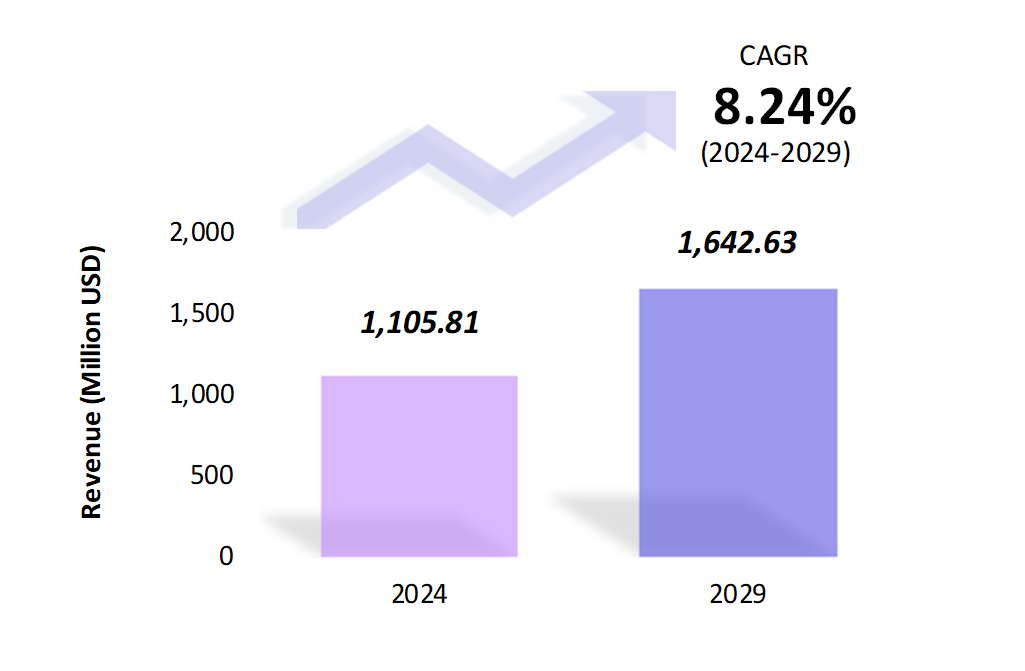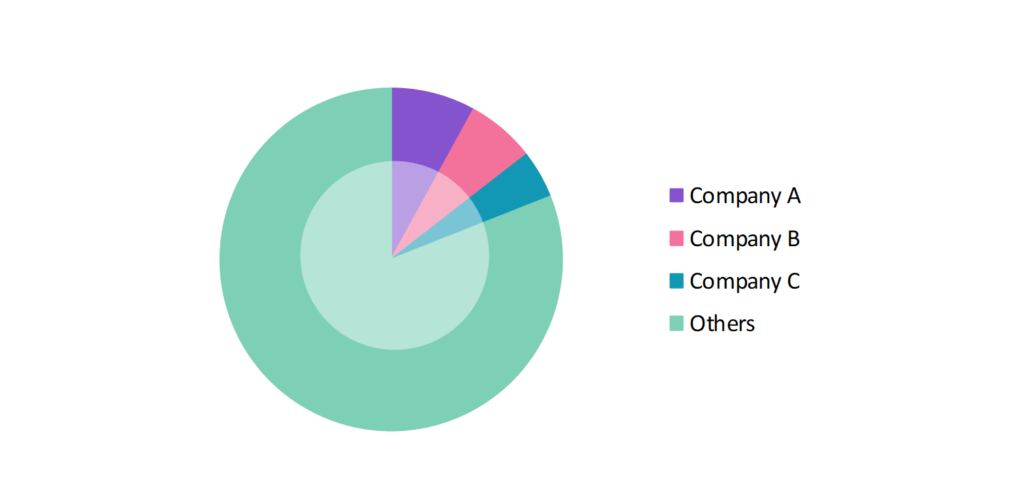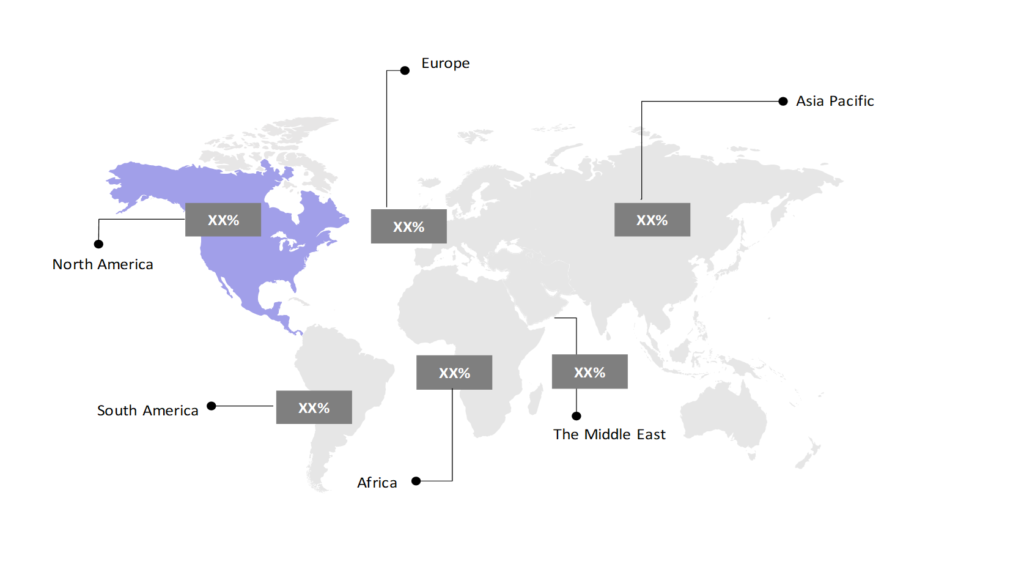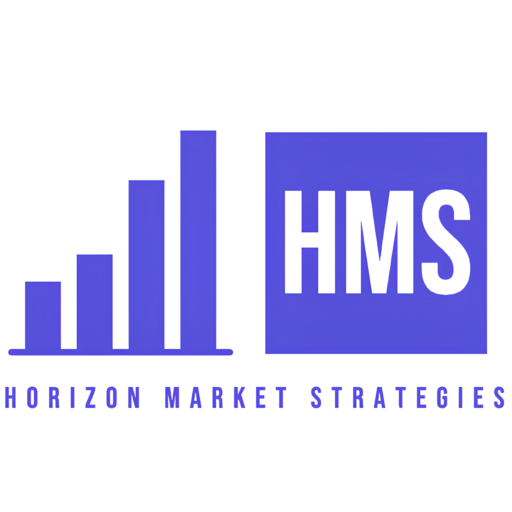Agriculture Supply Chain Market Outlook: Size, Share, Trends & Growth Analysis (2024-2029)
The market report presents a thorough analysis segmented by Component (Solution, Hardware, Services); by Solution (Transportation Management System, Supply Chain Planning, Warehouse Management System, Procedure and Sourcing, Manufacturing Execution System); by Deployment Model (On-Demand and Cloud-Based, On-Premises); by End User (Large Enterprises, Small & Medium Enterprises); by Geography (North America, South America, Asia Pacific, Europe, The Middle East, Africa).
Market Dimensions & Growth Potential

- The agriculture supply chain market is estimated to be at USD 1,105.81 Mn in 2024 and is anticipated to reach USD 1,642.63 Mn in 2029.
- The agriculture supply chain market is registering a CAGR of 8.24% during the forecast period of 2024-2029.
- The agriculture supply chain market has been experiencing significant growth, driven by advancements in technology and increasing demand for efficient supply chain management.
Request a free sample.
Competitive Landscape & Market Positioning in 2023

- The participants in the global agriculture supply chain industry are always developing their strategies to preserve a competitive advantage.
- These companies primarily use acquisitions, R&D, partnerships, and technological launches.
- Several important entities in the agriculture supply chain market include Eka Software Solutions Pvt. Ltd.; SAP SE; GrainChain, Inc.; LexisNexis Risk Solutions; IMB Corp. and others.
Ask for customization.
Report Objectives & Insights
| Attributes | Values |
| Historical Period | 2018-2022 |
| Base Year | 2023 |
| Forecast Period | 2024-2029 |
| Market Size (2024) | USD 1,105.81 Mn |
| Market Size (2029) | USD 1,642.63 Mn |
| Growth Rate | 8.24% CAGR from 2024 to 2029 |
| Key Segments | Component (Solution, Hardware, Services); Solution (Transportation Management System, Supply Chain Planning, Wearhouse Management System, Procedure and Sourcing, Manufacturing Execution System); Deployment Model (On-Demand and Cloud-Based, On-Premises); End User (Large Enterprises, Small & Medium enterprises); Geography (North America, South America, Asia Pacific, Europe, The Middle East, Africa) |
| Key Vendors | Eka Software Solutions Pvt. Ltd.; SAP SE; GrainChain, Inc.; LexisNexis Risk Solutions; IMB Corp. |
| Key Countries | The U.S; Canada; Brazil; China; India; Japan; The UK; Germany; Italy; France; Spain; South Africa |
| Largest Market | North America |
Get a free quote.
Market Trends & Future Outlook
- Adoption of Blockchain Technology: Blockchain technology is being increasingly adopted to enhance transparency and traceability in the agriculture supply chain. In October 2023, IBM’s Food Trust blockchain network reported a 30% increase in participation from agricultural producers and retailers, ensuring better product tracking and authenticity.
- Integration of IoT Devices: The use of Internet of Things (IoT) devices for monitoring and managing agricultural processes is on the rise. In June 2023, John Deere introduced a new range of IoT-enabled equipment that provides real-time data on soil conditions, crop health, and equipment performance, optimizing the supply chain.
- Increasing Use of AI and ML: Artificial Intelligence (AI) and machine learning (ML) are being utilized to predict demand, manage inventory, and optimize supply chain operations. In September 2023, Cargill implemented an AI-driven platform to forecast crop yields and manage logistics more efficiently, reducing waste and improving profitability.
Speak to analyst.
Key Market Influencers & Growth Drivers
- Rising Demand for Food Safety: The increasing demand for food safety and quality is boosting the adoption of advanced supply chain solutions. In January 2024, the Food and Drug Administration (FDA) implemented new regulations requiring detailed traceability of agricultural products, driving the need for robust supply chain management systems.
- Government Initiatives and Support: Governments worldwide are supporting the modernization of agricultural supply chains. In March 2024, the European Union announced 1.62 billion USD in funds to support the digitization of agricultural supply chains, aiming to enhance efficiency and sustainability.
- Increasing Consumer Awareness: Growing consumer awareness about food origin and production practices is driving the market. In April 2023, a survey by Nielsen revealed that 70% of consumers prefer purchasing products with transparent supply chain information, encouraging companies to adopt traceability technologies.
Inquire before buying.
Market Obstacles & Growth Barriers
- Complex Regulatory Environment: Navigating the complex regulatory environment for agricultural products can be challenging. In March 2024, the United States Department of Agriculture (USDA) introduced new guidelines for organic certification, requiring supply chain adjustments for compliance.
- High Implementation Costs: The initial cost of implementing advanced supply chain solutions can be prohibitive for small and medium-sized enterprises. In May 2023, a report by Deloitte indicated that 45% of SMEs found the cost of integrating technologies like blockchain and IoT into their supply chains a significant barrier.
- Shortage of Skilled Professionals: There is a growing shortage of skilled professionals who can manage and operate advanced supply chain systems. In May 2023, a survey by the U.S. Bureau of Labor Statistics indicated that 50% of agricultural businesses struggled to find qualified supply chain experts, impacting effective implementation and utilization.
Personalize this research.
Map Highlighting Key Region in 2023

Explore purchase options.
Table of Contents
| 1. Introduction |
|---|
| 1.1. Research Methodology |
| 1.2. Scope of the Study |
| 2. Market Overview / Executive Summary |
| 2.1. Global Agriculture Supply Chain Market (2018 – 2022) |
| 2.2. Global Agriculture Supply Chain Market (2023 – 2029) |
| 3. Market Segmentation |
| 3.1. Global Agriculture Supply Chain Market by Component |
| 3.1.1. Solution |
| 3.1.2. Hardware |
| 3.1.3. Services |
| 3.2. Global Agriculture Supply Chain Market by Solution |
| 3.2.1. Transportation Management System |
| 3.2.2. Supply Chain Planning |
| 3.2.3. Warehouse Management System |
| 3.2.4. Procedure and Sourcing |
| 3.2.5. Manufacturing Execution System |
| 3.3. Global Agriculture Supply Chain Market by Deployment Model |
| 3.3.1. On-Demand and Cloud-Based |
| 3.3.2. On-Premises |
| 3.4. Global Agriculture Supply Chain Market by End User |
| 3.4.1. Large Enterprises |
| 3.4.2. Small & Medium Enterprises |
| 4. Regional Segmentation |
| 4.1. North America |
| 4.1.1. The US |
| 4.1.2. Canada |
| 4.1.3. Mexico |
| 4.2. South America |
| 4.2.1. Brazil |
| 4.2.2. Argentina |
| 4.2.3. Colombia |
| 4.2.4. Chile |
| 4.2.5. Rest of South America |
| 4.3. Asia Pacific |
| 4.3.1. China |
| 4.3.2. India |
| 4.3.3. Japan |
| 4.3.4. South Korea |
| 4.3.5. Rest of Asia Pacific |
| 4.4. Europe |
| 4.4.1. The UK |
| 4.4.2. Germany |
| 4.4.3. Italy |
| 4.4.4. France |
| 4.4.5. Spain |
| 4.4.6. Rest of Europe |
| 4.5. The Middle East |
| 4.5.1. Turkey |
| 4.5.2. UAE |
| 4.5.3. Saudi Arabia |
| 4.5.4. Rest of the Middle East |
| 4.6. Africa |
| 4.6.1. Egypt |
| 4.6.2. South Africa |
| 4.6.3. Rest of Africa |
| 5. Value Chain Analysis of the Global Agriculture Supply Chain Market |
| 6. Porter Five Forces Analysis |
| 6.1. Threats of New Entrants |
| 6.2. Threats of Substitutes |
| 6.3. Bargaining Power of Buyers |
| 6.4. Bargaining Power of Suppliers |
| 6.5. Competition in the Industry |
| 7. Trends, Drivers and Challenges Analysis |
| 7.1. Market Trends |
| 7.1.1. Market Trend 1 |
| 7.1.2. Market Trend 2 |
| 7.1.3. Market Trend 3 |
| 7.2. Market Drivers |
| 7.2.1. Market Driver 1 |
| 7.2.2. Market Driver 2 |
| 7.2.3. Market Driver 3 |
| 7.3. Market Challenges |
| 7.3.1. Market Challenge 1 |
| 7.3.2. Market Challenge 2 |
| 7.3.3. Market Challenge 3 |
| 8. Opportunities Analysis |
| 8.1. Market Opportunity 1 |
| 8.2. Market Opportunity 2 |
| 8.3. Market Opportunity 3 |
| 9. Competitive Landscape |
| 9.1. Eka Software Solutions Pvt |
| 9.2. SAP SE |
| 9.3. GrainChain, Inc. |
| 9.4. LexisNexis Risk Solutions |
| 9.5. IMB Corp. |
| 9.6. Company 6 |
| 9.7. Company 7 |
| 9.8. Company 8 |
| 9.9. Company 9 |
| 9.10. Company 10 |
Know the research methodology.
Agriculture Supply Chain Market – FAQs
What is the current size of the agriculture supply chain market?
In 2024, the agriculture supply chain market size is $1,105.81 Mn.
Who are the major vendors in the agriculture supply chain market?
The major vendors in the agriculture supply chain market are Eka Software Solutions Pvt. Ltd.; SAP SE; GrainChain, Inc.; LexisNexis Risk Solutions; IMB Corp.
Which segments are covered under the agriculture supply chain market segments analysis?
The agriculture supply chain market report offers in-depth insights into Component, Solution, Deployment Model, End User, and Geography.
